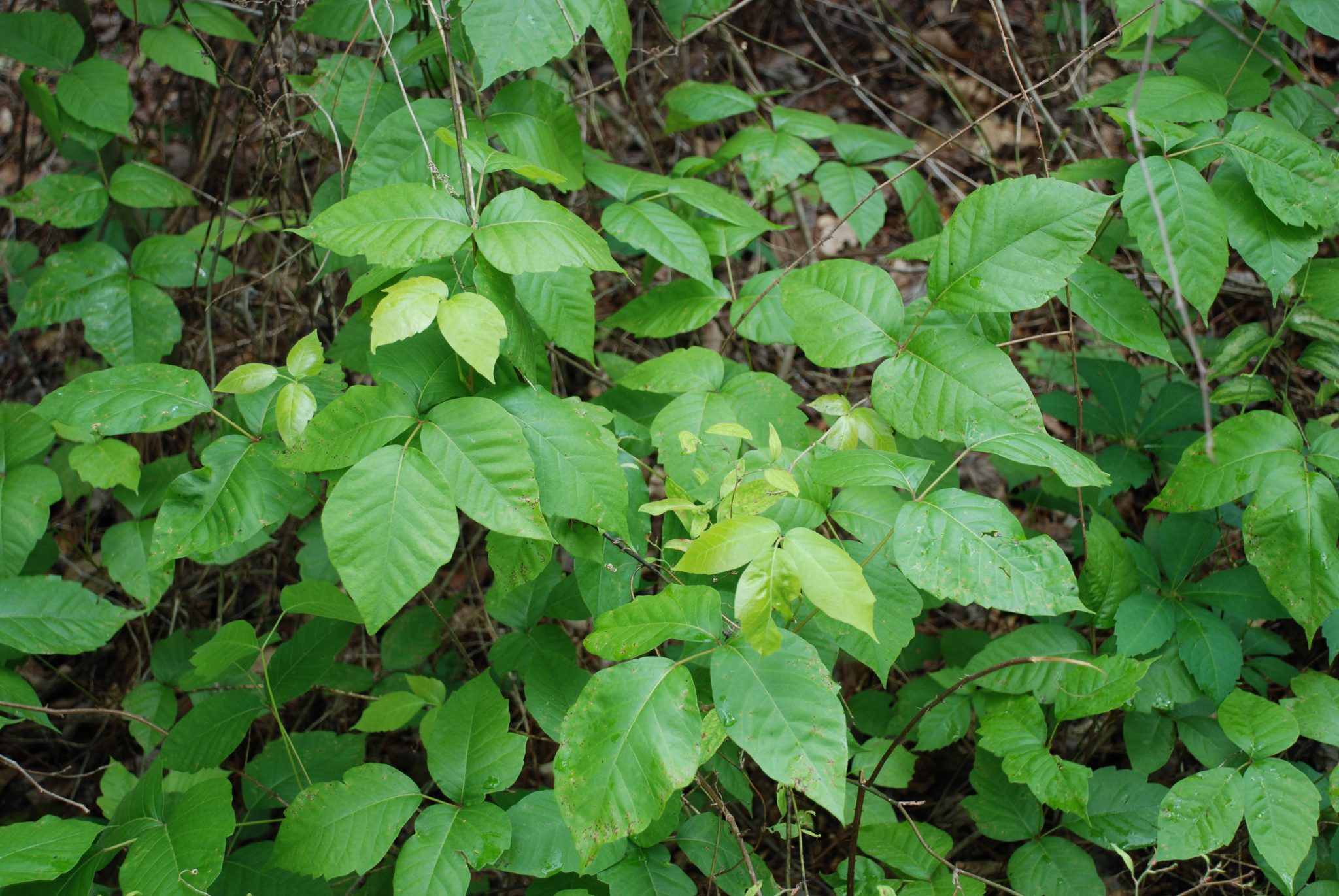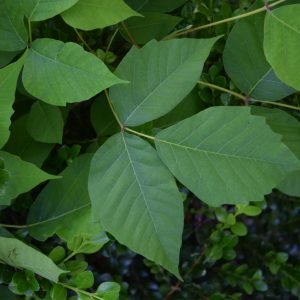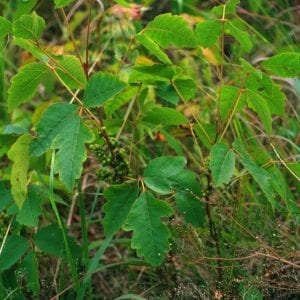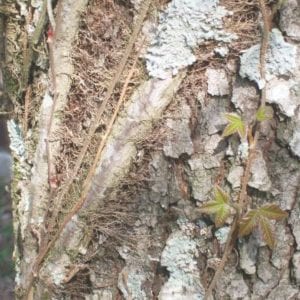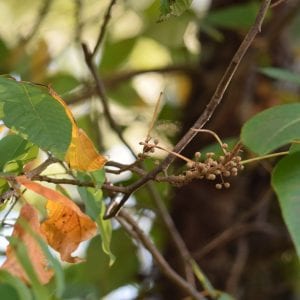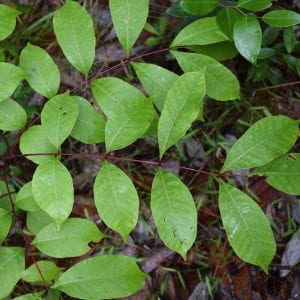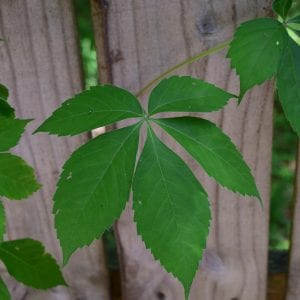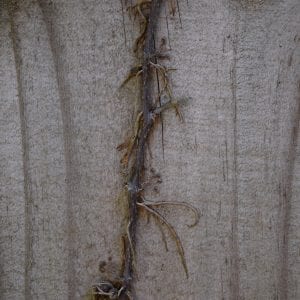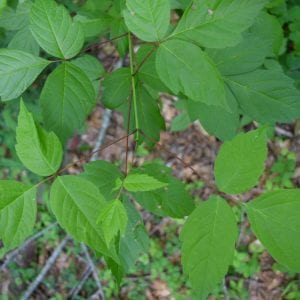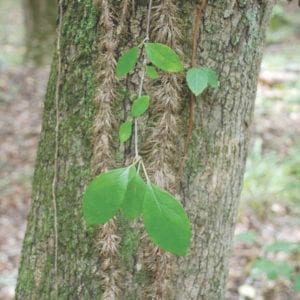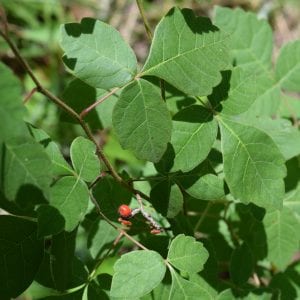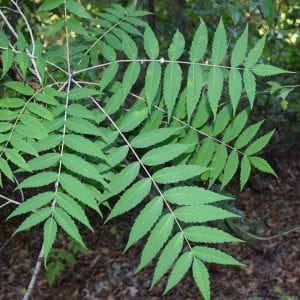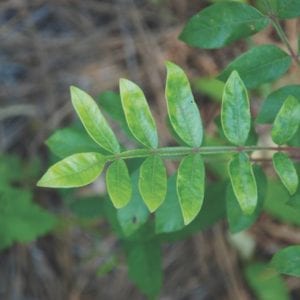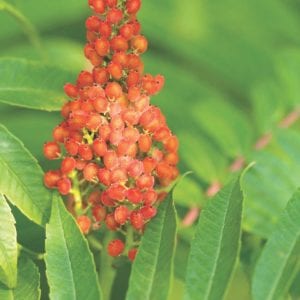Forestry

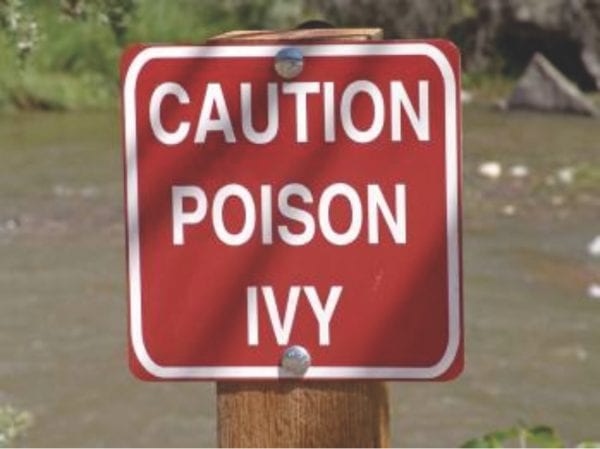 Knowing how to identify these poisonous plants can help you avoid an itchy experience. Learn what to look for, how to treat allergic reactions, and how to control plant invasion.
Knowing how to identify these poisonous plants can help you avoid an itchy experience. Learn what to look for, how to treat allergic reactions, and how to control plant invasion.
Summertime usually means more time outdoors, where there is an increased risk of experiencing a brush with poison ivy (Toxicodendron radicans), poison oak (T. pubescens), or poison sumac (T. vernix). Knowing what to look for can help you avoid these toxic plants. But sometimes that isn’t enough and contact is made. It is important to know how the poison spreads, how to treat reactions, and how to safely eliminate these unwelcome plants.
Identification
Poison Ivy and Poison Oak
The leaves of poison ivy (figure 1) and poison oak (figure 2) have three leaflets. This is where the adage leaves of three, let it be comes from. The leaflets are commonly 2 to 8 inches long and 3⁄4 to 5 inches wide, and they have scattered, jagged teeth along the edges. Some have a larger tooth or lobe close to the bottom edge, giving them a mitten-like shape.
The teeth on the leaflets of poison oak tend to be more rounded (figure 2), while those of poison ivy are more pointed (figure 1). There is often a reddish spot where the two bottom leaflets join together.
Poison ivy grows as a vine that may run along the ground or up the sides of trees, houses, or other vertical surfaces. The vines can reach more than 2 inches in diameter. Larger vines often appear “hairy” due to tiny roots that extend from the vine (figure 3). In contrast, poison oak is more shrub-like, and its leaves often are crowded near the tips of upright stems, which can reach 3 feet tall. Both species produce clusters of small white to tan fruit (figure 4).
Poison ivy is found in a wide variety of habitats but is especially common in wooded areas, along forest edges, and in urban green spaces. Poison oak is typically found in dry pine and scrub oak forests or other dry sites.
- Figure 1. Poison ivy leaves have three leaflets. Leaflets have scattered, jagged teeth along the edges and may have a larger tooth or lobe close to the bottom edge of the leaflet, giving it a mitten-like shape. There is often a red spot where the bottom two leaflets join together.
- Figure 2. Poison oak looks similar to poison ivy, but the teeth along the edges of the leaflets are more rounded, leaves often are not as shiny, and the form is more shrub-like (photo by John Byrd, bugwood.org).
- Figure 3. Poison ivy vines, ranging in size from the thin new one on the right to the large hairy ones on the left. Note that the new stems are not as hairy. (Photo by Amber C. Marable)
Poison Sumac
Poison sumac is a close relative of poison ivy and poison oak, but it looks very different. Poison sumac leaves have seven to fifteen leaflets that are commonly 2 to 4 inches long and 3⁄4 to 2 inches wide. The leaflets, which are arranged along the stem in pairs (figure 5), are oblong with sharply pointed tips and smooth or somewhat wavy edges. The stems and leaf stalks often are a bright red color. Poison sumac grows as a shrub or small tree, reaching up to 20 feet tall, and is typically found only in open or wooded swampy areas. Smooth, greenish white fruit produced during late summer may persist on the plant through the fall and winter.
- Figure 4. Poison ivy fruit ripens in the late summer or early fall.
- Figure 5. Poison sumac leaves have seven to fifteen leaflets with smooth to wavy margins. Note the bright red color of the stems.
- Figure 6. Virginia creeper leaves typically have five leaflets.
Look-alikes
Virginia creeper (Parthenocissus quinquefolia) and poison ivy often grow together and are frequently confused with each other. Young Virginia creeper leaves or those that have been damaged may occasionally have three leaflets, but most have five (figure 6). Plants of both species often have a reddish center where the leaflets join. Another difference between the two is that Virginia creeper vines are much less hairy than poison ivy vines. Virginia creeper has fewer, more widely spaced rootlets, and some rootlets have small attachment disks at the ends (figure 7). Only rarely does contact with Virginia creeper leaves or stems cause an allergic reaction in sensitive individuals. The plant is generally considered harmless, although the fruit can be harmful if eaten.
Box elder (Acer negundo) seedlings have leaves with three leaflets and can look like poison ivy at first glance. Box elder leaves, however, are arranged opposite each other along the stem (figure 8); poison ivy leaves are arranged alternately along the stem.
Climbing hydrangea (Decumaria barbara) vines are hairy and may appear very similar to poison ivy, but they have opposite, simple leaves with smooth edges or just a few shallow teeth (figure 9).
- Figure 7. Virginia creeper vines are generally less “hairy” than poison ivy vines. There are some short rootlets. Note the clasping rootlets that have what look like small suction cups at the tips.
- Figure 8. Boxelder leaves can look very similar to poison ivy leaves, but they are opposite each other on the stem.
- Figure 9. Climbing hydrangea vines are hairy and can resemble poison ivy vines, but the leaves are simple and opposite each other along the vine.
Fragrant sumac (Rhus aromatica) is often mistaken for poison oak, and both grow in similar habitats. One difference is that the leaflets of fragrant sumac are attached at a single point, while the terminal leaflet of poison oak has a short stem. Also, the fruit of the fragrant sumac plant is red (figure 10).
Smooth sumac (Rhus glabra) and winged sumac (Rhus copallinum) are commonly occurring shrubs that may be mistaken for poison sumac, but there are several clear differences. The leaflets of smooth sumac have teeth along the edges and are greater in number (eleven to thirty-one) than those seen in poison sumac (figure 11). Winged sumac is easily identified by the leafy wings along the leaf stalk (figure 12). Neither species is likely to cause skin irritation, although some people may be sensitive to the sap. The fruits of both nonpoisonous sumacs are red (figure 13), unlike those of poison sumac.
A good rule of thumb to follow for any look-alike plant is, If you’re not sure, don’t touch it!
- Figure 10. Fragrant sumac leaflets join at a single point and the fruit is red.
- Figure 11. Smooth sumac leaves have eleven to thirty-one leaflets. Note that the leaflets have teeth along the edges.
- Figure 12. Winged sumac leaves have leafy material along the leaf stalk.
- Figure 13. Nonpoisonous sumacs have red fruit.
Response to Exposure
Touching any of the three poisonous species may result in a red, swollen, and painful rash of itchy blisters. Rashes can occur in patches or in streaks and lines.
About 85 percent of people are allergic to urushiol, the oily compound responsible for the skin reaction. Urushiol is found in all parts of these plants. Simply touching the leaves may expose you to the oil, and additional oil is released when plant parts are crushed or damaged. The oil resists breakdown and may cling to clothing, tools, and pet fur for long periods of time, even a year or more. Exposure to the oil on these secondary sources can also cause an allergic reaction.
Not everyone is allergic to these plants, and sensitivity varies between people, but allergies may develop with increased contact. Thus, it’s a good idea for everyone to avoid these plants.
People suffering from a rash caused by these plants need not worry about spreading it to other parts of the body or to other individuals. After the rash appears, it is not contagious, and any observed spreading of the rash is the result of a delay in reaction from previous exposure or from re-exposure due to contact with clothing and equipment that has not been properly cleaned. Although the rash may be visible in as little as a few hours, it may take up to 3 weeks for the entire rash to appear.
Treatment
In mild cases, hydrocortisone creams or other anti- itch creams can be applied to soothe irritation. Some products are marketed specifically for treatment of poison ivy and poison oak rashes and can be obtained over-the-counter at local pharmacies. Calamine lotion and oral antihistamines also can provide some relief. Other suggestions include cold packs, oatmeal baths, and compresses containing Burow’s solution (mixture of aluminum acetate and water), which is available over- the-counter at most pharmacies. Most cases will clear up in a matter of weeks without further medical attention.
Approximately 10 to 15 percent of people will have reactions severe enough to require medical treatment, often in the form of oral or injected low-dose steroids administered by a doctor. Seek medical help if the rash becomes infected, covers a large part of the body, causes swelling of the face or other sensitive areas, or causes difficulty with swallowing or breathing.
Eating the plants can cause severe internal irritation, and inhaling particles of urushiol released by burning poison ivy, oak, or sumac can cause swelling of the respiratory passages, which can even result in death. These cases require specific and immediate medical treatment.
Control
Controlling infestations of poison ivy, poison oak, and poison sumac plants can be tricky because contact must be avoided. It may be tempting to burn a patch that intrudes in a backyard, but under no circumstances should you burn any part of these poisonous plants. Urushiol will become airborne in the smoke, and inhalation may cause severe swelling of the esophagus and respiratory passages, resulting in difficulty breathing and potentially death. Likewise, trimming or mowing patches or vines can cause particles of the allergen to become airborne.
The safest way to control these poisonous plants in your yard is by using an herbicide spray. Effective herbicides containing glyphosate and triclopyr, some specifically labelled for poison ivy control, can be found in the gardening section of most general stores. Follow instructions on the packaging label. Be patient and persistent, as several applications may be necessary to kill these hardy plants.
If it becomes necessary to cut the vines, keep in mind that severing the vines will release sap, and some urushiol may become airborne or drop from overhead leaves. The utmost care should be taken that no particles are inhaled. When cutting a vine, wear protective clothing (long sleeves, pants, and close-toed shoes), and a dust mask. Try not to sever these vines on a windy day, as this will increase the likelihood of allergens being spread. It is also best to do this in the winter, when sap is less abundant in the plant tissue. Keep in mind, however, that the vines can cause a rash any time of year.
If you’re unsure or uncomfortable with managing the problem, it may be best to hire a professional to control these poisonous plants.
Learn to recognize poisonous plants and follow these tips:
- Wear long pants and close-toed shoes when in the woods.
- Carefully inspect tree trunks to avoid any vines before touching them.
- Be wary of leafy green plants that carpet the forest floor.
- Avoid contact with these plants even if not allergic. Additional exposure may lead to development of an allergy.
- Do not burn any part of these plants. The allergen may become airborne and be inhaled.
- Wear vinyl gloves with long sleeves tucked in when weeding gardens where poison ivy is present, and clean tools and gloves when done.
- Apply a preventative lotion, such as Ivy Block, before going outdoors to help reduce exposure.
- Wash skin with soap and water or rubbing alcohol within 10 to 20 minutes if contact is suspected. Rinse thoroughly. Do not use hot water, as this may make the problem worse by opening skin pores.
- Wash clothes immediately upon return from outdoor recreation.
 Nancy Loewenstein, former Extension Specialist, School of Forestry and Wildlife Sciences, Auburn University; Amber C. Dunn, former 4-H Regional Extension Agent; and Mark D. Smith, Professor, School of Forestry and Wildlife Sciences, Auburn University.
Nancy Loewenstein, former Extension Specialist, School of Forestry and Wildlife Sciences, Auburn University; Amber C. Dunn, former 4-H Regional Extension Agent; and Mark D. Smith, Professor, School of Forestry and Wildlife Sciences, Auburn University.
Revised November 2025, Touch-Me-Nots: Poison Ivy, Poison Oak, and Poison Sumac, ANR-1460

